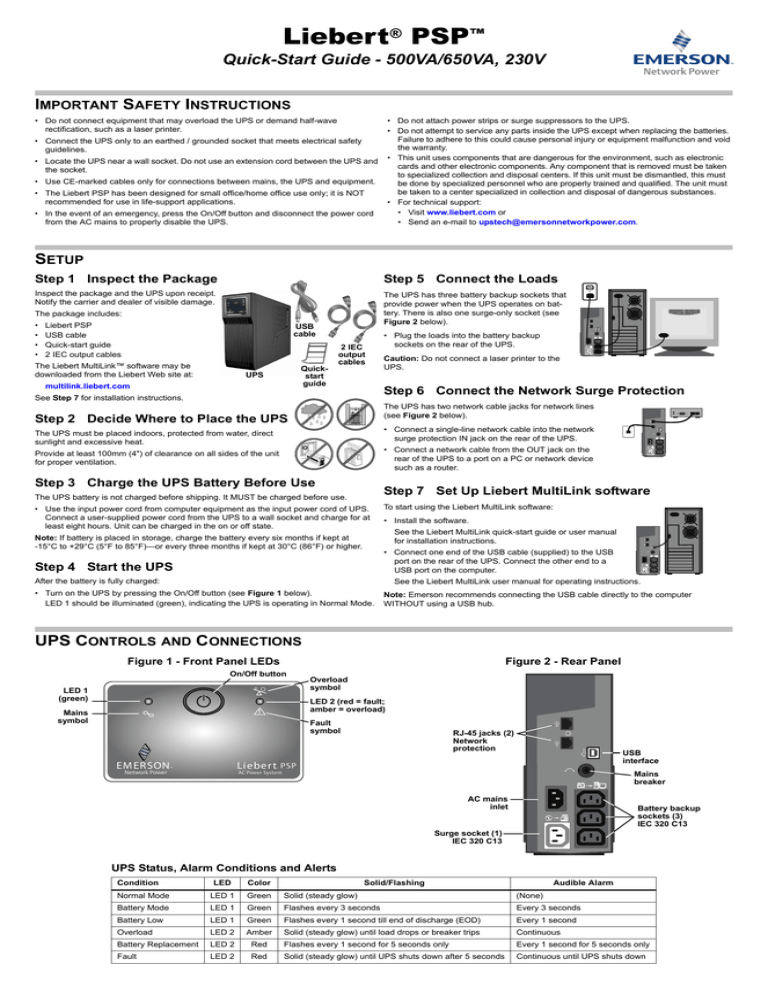
Liebert® PSP™
Quick-Start Guide - 500VA/650VA, 230V
IMPORTANT SAFETY INSTRUCTIONS
• Do not connect equipment that may overload the UPS or demand half-wave
rectification, such as a laser printer.
• Do not attach power strips or surge suppressors to the UPS.
• Do not attempt to service any parts inside the UPS except when replacing the batteries.
Failure to adhere to this could cause personal injury or equipment malfunction and void
the warranty.
• This unit uses components that are dangerous for the environment, such as electronic
cards and other electronic components. Any component that is removed must be taken
to specialized collection and disposal centers. If this unit must be dismantled, this must
be done by specialized personnel who are properly trained and qualified. The unit must
be taken to a center specialized in collection and disposal of dangerous substances.
• For technical support:
• Visit www.liebert.com or
• Send an e-mail to upstech@emersonnetworkpower.com.
• Connect the UPS only to an earthed / grounded socket that meets electrical safety
guidelines.
• Locate the UPS near a wall socket. Do not use an extension cord between the UPS and
the socket.
• Use CE-marked cables only for connections between mains, the UPS and equipment.
• The Liebert PSP has been designed for small office/home office use only; it is NOT
recommended for use in life-support applications.
• In the event of an emergency, press the On/Off button and disconnect the power cord
from the AC mains to properly disable the UPS.
SETUP
Step 1 Inspect the Package
Step 5 Connect the Loads
Inspect the package and the UPS upon receipt.
Notify the carrier and dealer of visible damage.
The UPS has three battery backup sockets that
provide power when the UPS operates on battery. There is also one surge-only socket (see
Figure 2 below).
The package includes:
•
•
•
•
Liebert PSP
USB cable
Quick-start guide
2 IEC output cables
USB
cable
The Liebert MultiLink™ software may be
downloaded from the Liebert Web site at:
Quickstart
guide
UPS
multilink.liebert.com
2 IEC
output
cables
• Plug the loads into the battery backup
sockets on the rear of the UPS.
Caution: Do not connect a laser printer to the
UPS.
Step 6 Connect the Network Surge Protection
See Step 7 for installation instructions.
The UPS has two network cable jacks for network lines
(see Figure 2 below).
Step 2 Decide Where to Place the UPS
• Connect a single-line network cable into the network
surge protection IN jack on the rear of the UPS.
The UPS must be placed indoors, protected from water, direct
sunlight and excessive heat.
• Connect a network cable from the OUT jack on the
rear of the UPS to a port on a PC or network device
such as a router.
Provide at least 100mm (4") of clearance on all sides of the unit
for proper ventilation.
Step 3 Charge the UPS Battery Before Use
Step 7 Set Up Liebert MultiLink software
The UPS battery is not charged before shipping. It MUST be charged before use.
• Use the input power cord from computer equipment as the input power cord of UPS.
Connect a user-supplied power cord from the UPS to a wall socket and charge for at
least eight hours. Unit can be charged in the on or off state.
Note: If battery is placed in storage, charge the battery every six months if kept at
-15°C to +29°C (5°F to 85°F)—or every three months if kept at 30°C (86°F) or higher.
To start using the Liebert MultiLink software:
• Install the software.
See the Liebert MultiLink quick-start guide or user manual
for installation instructions.
• Connect one end of the USB cable (supplied) to the USB
port on the rear of the UPS. Connect the other end to a
USB port on the computer.
Step 4 Start the UPS
After the battery is fully charged:
See the Liebert MultiLink user manual for operating instructions.
• Turn on the UPS by pressing the On/Off button (see Figure 1 below).
LED 1 should be illuminated (green), indicating the UPS is operating in Normal Mode.
Note: Emerson recommends connecting the USB cable directly to the computer
WITHOUT using a USB hub.
UPS CONTROLS AND CONNECTIONS
Figure 1 - Front Panel LEDs
Figure 2 - Rear Panel
On/Off button
LED 1
(green)
LED 2 (red = fault;
amber = overload)
!
Mains
symbol
Overload
symbol
Fault
symbol
EM ERSON
Network Power
Lieber t
™
®
RJ-45 jacks (2)
Network
protection
USB
interface
PSP
Mains
breaker
AC Power System
AC mains
inlet
Battery backup
sockets (3)
IEC 320 C13
Surge socket (1)
IEC 320 C13
UPS Status, Alarm Conditions and Alerts
Condition
LED
Color
Solid/Flashing
Audible Alarm
Normal Mode
LED 1
Green
Solid (steady glow)
(None)
Battery Mode
LED 1
Green
Flashes every 3 seconds
Every 3 seconds
Battery Low
LED 1
Green
Flashes every 1 second till end of discharge (EOD)
Every 1 second
Overload
LED 2
Amber
Solid (steady glow) until load drops or breaker trips
Continuous
Battery Replacement
LED 2
Red
Flashes every 1 second for 5 seconds only
Every 1 second for 5 seconds only
Fault
LED 2
Red
Solid (steady glow) until UPS shuts down after 5 seconds
Continuous until UPS shuts down
REPLACING THE BATTERY
Servicing of batteries should be performed or supervised by personnel knowledgeable about batteries and required precautions.
When replacing batteries, replace with the same type and size battery.
! CAUTION
Do not dispose of batteries in a fire. The batteries may explode.
! CAUTION
Do not open or mutilate batteries. Released electrolyte is harmful to the skin and eyes. It is toxic.
This product is designed for IT power systems with 230V.
To replace the battery:
1.
2.
3.
4.
5.
6.
7.
8.
9.
Step 1
Turn off all connected loads, then turn off the UPS and unplug the input
power cord. (Batteries are NOT hot-swappable.)
Carefully lay the UPS on its left side, as shown in the diagram.
Use a #1 Phillips head screwdriver to remove the four screws from the
right-side cover, then pull up the right-side cover and remove it.
Remove the black wire from the negative (-) terminal and the red wire from
the positive (+) terminal.
Gently remove the battery from the UPS.
Attention: Risk of Electric Shock.
Verify that the replacement battery matches the dimensions and battery
specifications.
Connect the battery leads to the new battery. Be sure to reconnect the red
wire to the positive (+) terminal and the black wire to the negative (-)
terminal.
Note: Small sparks may occur at the battery connectors during
reconnection. Take care not to short-circuit the positive and negative
battery terminals while replacing the battery.
Place the battery in the UPS.
Ensure correct alignment of front panel, then reattach the right-side cover.
Evenly tighten the four screws from Step 3. (Do NOT overtighten screws.)
ATTENTION:
Risk of
Electric Shock
Steps 2 and 3
Dispose of the old battery properly at an appropriate recycling facility.
TROUBLESHOOTING
If the UPS detects a fault, consult the table below for possible causes and solutions. For further assistance, please contact your local Emerson Network Power representative.
Fault
Possible Causes
Mains is normal, but LED 1 is not illuminated.
LED 1 flashes (green) every 3 seconds, but there is
no output power.
Alarm buzzer beeps continuously although mains is
normal.
UPS does not provide expected backup time.
The UPS is on and connected to mains, but fails to
operate properly.
Solutions
The UPS may not be turned on.
• Press the On/Off button to turn on the UPS.
The power cord may not be connected properly.
• Connect the power cord securely into a wall socket.
The upstream mains circuit breaker may be tripped.
• Reset the circuit breaker.
Battery voltage may be too low.
• Recharge the UPS for 8 hours.
The UPS may be overloaded (check LED 2).
• Disconnect some equipment from the UPS.
The UPS battery reached end of life.
• Replace the internal battery.
• If mains is normal, try reconnecting mains and
restarting the UPS.
Mains power may be outside the unit’s operating range.
SPECIFICATIONS
Model Number
Capacity (VA/W)
PSP500MT3-230U
PSP650MT3-230U
500/300
650/390
Net Weight, kg (lb.)
3.9 (8.6)
Shipping Weight, kg (lb.)
4.8 (10.6)
Dimensions - W x D x H, mm (in.)
87 x 215 x 251 (3.4 x 8.5 x 9.9)
Mains Voltage
160-287VAC
Frequency
50/60Hz ±5Hz
Output Voltage (Mains Normal)
Typical 160-287VAC
Output Voltage (Battery Operation)
230VAC ±5%
On-Battery Wave Form
Stepped sinewave
VRLA Battery Type - VDC x Ah x Quantity
12V x 7.2Ah x 1
Typical Recharge Time
12V x 7.2Ah x 1
6-8 hours to 90%
Battery Run Time
See Load Autonomy table at right
Audible and Visual
Audible alarm / LED
Load (watts)
500VA
650VA
IEC 320 C13 (3)
50
55
56
IEC 320 C13 (1)
100
18
19
0 to 40 (32 to 104)
150
12
12
Backup Sockets
Surge Sockets
Operating Temperature, °C (°F)
Storage Temperature, °C (°F)
Operating / Storage Relative Humidity
-15 to 40 (5 to 104)
200
8
8
0%-90%, non-condensing
250
5
5
Class B
300
N/A
4
350
N/A
3
EMI Classification
Agency
Safety
EMC
Transportation
Load Autonomy - Liebert PSP 230V 500VA-650VA
IEC/EN/AS 62040-1-1
EN 62040-2:2005 Class B
IEC 61000-4-2 Electrostatic discharge
IEC 61000-4-3 Radiated E-RFI fields
IEC 61000-4-4 Fast E transients
IEC 61000-4-5 Surges/Lightning
IEC 61000-4-6 Conducted RFI
Note: All run times are in minutes, assume fully charged
batteries and are typical at 25°C (77°F) with resistive loads.
ISTA Procedure 1A Certification
Note: The Liebert PSP is compliant with the Restriction of Hazardous Substances Directive (ROHS),
prohibiting use of six hazardous materials manufacturing of electronics, including lead-free solder.
© 2009 Liebert Corporation All rights reserved throughout the
world. Specifications subject to change without notice.
® Liebert is a registered trademark of Liebert Corporation.
All names referred to are trademarks or registered trademarks
of their respective owners.
SLI-23285_REV0_03-09
Technical Support / Service
800-222-5877
(Outside U.S. 614-841-6755)
upstech@emersonnetworkpower.com
Web site: www.liebert.com
Europe
Via Leonardo Da Vinci 8
Zona Industriale Tognana
35028 Piove Di Sacco (PD) Italy
+39 049 9719 111
Fax: +39 049 5841 257
Asia
7/F Dah Sing Financial Centre
108 Gloucester Road
Wanchai, Hong Kong
852 2572 2201
Fax: 852 2519 9210
United States
1050 Dearborn Drive
P.O. Box 29186
Columbus, OH 43229



